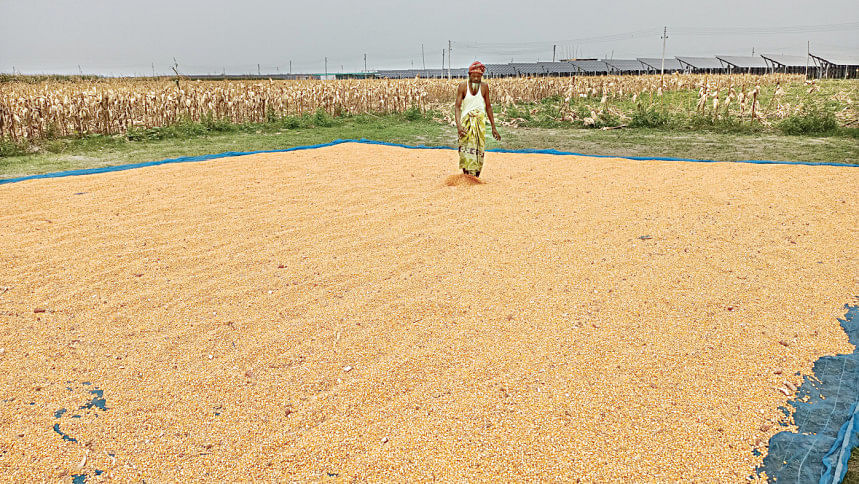Maize farmers lament price drop amid a rise in costs

Maize cultivation remains a profitable venture for farmers, although many in districts where production is concentrated have voiced concerns over a drop in market prices this season amid a rise in production costs.
The crop's cultivation is concentrated in the country's northern region, with the leading districts being Lalmonirhat, Dinajpur, Chuadanga, Thakurgaon, Rangpur, Panchagarh, Nilphamari, Jhenaidah, Jamalpur and Gaibandha.
Farmers in Lalmonirhat, Kurigram, Rangpur and Dinajpur report that prices have declined by Tk 2 to Tk 3 from those in the previous season to Tk 28 to Tk 29 per kilogramme (kg).
The cost of production has increased by a similar margin to Tk 11 to Tk 13 per kg.
In terms of land area or every bigha (2,529 square metres), the cost stands between Tk 14,000 and Tk 16,000, subject to variations due to land lease rates and ancillary expenses.
A typical yield per bigha ranges from 35 maunds to 45 maunds (one maund equals around 37 kg).
Each maund sells for Tk 1,100 to Tk 1,300.
This results in net profits of approximately Tk 28,000 to Tk 34,000 per bigha, cementing maize's status as one of the most financially viable crops.
Nevertheless, traders are reportedly purchasing maize at lower prices this year, citing acreage expansion and a bumper harvest.
Farmers argue that while yields are indeed robust, the combination of reduced prices and increased input costs is eroding their profit margins and may deter future planting.
Such volatility has prompted calls for more stable pricing mechanisms and fairer market access—factors that many believe are crucial to the long-term sustainability of maize farming. According to the Department of Agricultural Extension (DAE), Bangladesh produced 68.84 lakh tonnes of maize from 6.42 lakh hectares of land in fiscal year 2023–24. The target for fiscal year 2024–25 has been set at 71.60 lakh tonnes from 6.51 lakh hectares of land.
National demand currently hovers around 70 lakh tonnes to 75 lakh tonnes.
Agricultural economist Jahangir Alam noted, "Last year, we had to import four lakh tonnes of maize. This year, dependency on imports will reduce. Until domestic production satisfies national demand, expansion must continue."

He cautioned that increased production combined with falling global prices could further depress domestic prices.
A government-fixed market price for maize would be beneficial, he added, describing the crop as a mode of cash generation that has reinvigorated rural economies.
In the Rangpur region, comprising Lalmonirhat, Kurigram, Gaibandha, Rangpur and Nilphamari, maize has been cultivated on 1.47 lakh hectares of land this year with a production target of 15.60 lakh tonnes.
Notably, approximately half of this is char areas—fertile floodplains prone to seasonal submersion.
In Lalmonirhat, maize is cultivated on 39,505 hectares, primarily on the sandy char lands of the Teesta river. Many local farmers have seen transformative improvements in their livelihoods through maize cultivation.
Shafiqul Islam, additional director of the DAE's Rangpur division, explained that maize was predominantly cultivated during the Rabi (winter) season, with planting running in October–November and harvests in March–April.
The season benefits from favourable weather and allows companion cropping. Although some cultivation occurs in the Kharif or monsoon season, yields are typically lower.
Shahidar Rahman, a seasoned farmer of Char Saniajan in Lalmonirhat's Hatibandha upazila, has been growing maize on 10 bighas of sandy land along the Teesta for 15 years.
"I've harvested 43 maunds per bigha on eight bighas so far, spending a total of Tk 2.8 lakh. Without maize, I would still be mired in poverty," he said.
Similarly, Afiar Rahman of Char Bhotmari in Lalmonirhat's Kaliganj upazila voiced disappointment over this year's price drop. "If prices matched last year's, we could have earned much more," he said, informing that he had harvested 326 maunds from eight bighas, incurring a cost of Tk 1.28 lakh.
Wholesalers also noted tight profit margins.
Jamilur Rahman of Chilmari, Kurigram, said, "We buy maize at Tk 27–28 per kg and sell it to feed mills for Tk 29. After transport, our margin is minimal."
He cited abundant supply and increased cultivation as factors driving the price dip.
Bablu Mia, a wholesaler in Bhotmari, echoed this, stating, "Transport costs from the char areas are high. I buy from char farmers at Tk 27 and sell at Tk 29. With strong yields, prices could fall further."
From the industry side, Azizar Rahman, a procurement representative of Aftab Feed Mill, explained that purchases were aligned with global trends.
"We prioritise local produce over imports. If global prices rise, farmers will benefit domestically," he said.
Afzal Hossain, a Rangpur-based feed producer, noted that despite robust production, feed prices are unlikely to drop due to high bank interest rates, service charges and other operating costs.
Procurement centres in high-output areas enable direct purchases from farmers, improving supply chain efficiency, he said. Mizanur Haque, senior vice-president of Bangladesh Maize Association, warned of growing monopolistic behaviour.
"Previously, we could ensure fair returns for farmers. Now, syndicates led by feed mill owners are dictating prices," he claimed.
He added that falling global wheat prices and increased maize production have further suppressed the market.

 For all latest news, follow The Daily Star's Google News channel.
For all latest news, follow The Daily Star's Google News channel. 



Comments